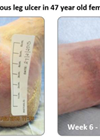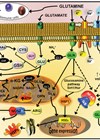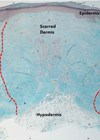Advances in technology have allowed scientists to expand their understanding of the complex interactions that occur between humans and the microbes that reside on and inside their bodies. However, these same advances present a challenge to scientists and clinicians to reinterpret some of the learnings gleaned through research performed in decades past.
One philosophy that has begun to bubble up in recent years is that of holobiontology, derived from the study of the holobiont – a term used to describe an assembly of a host organism and all the host’s resident microorganisms. This concept, derived from the idea that to optimally care for any complex organism, the entire ecosystem in which that organism exists must be considered. More specifically, we will focus on how this translates to the holobiont with respect to the human skin and how the interaction between humans and their respective skin microbiomes can affect their overall health and wellbeing. This deviates slightly from traditional therapies in the sense that we must also consider the effect of therapies on our microflora, and its coincident implications.
No matter how clean one perceives themselves to be, there will always be billions, perhaps trillions, of microbes on the skin. Microbes that are engrafted on the skin constantly feed on substances that are available, either naturally (e.g. sebum) or artificially (e.g. topicals). More importantly, each microbe is also secreting substance(s) all the time. What those microbes secrete is often correlated to both the food sources they have available and the environment they are put in. Microbes, like most organisms, are reactive to changes in their ecosystems. This manifests in differences in the secretome of microbes seen between growth phase versus stationary phase, pure culture versus a mixture of microbes, using one carbon source versus another, and under oxidative stress versus anaerobic conditions. This is just to name a few of the environmental changes that can affect the microbial secretome.
Importantly, there is the issue of the significant phylotypic and genetic differences between strains within any given species. It has been known for quite some time that the characteristics of any given microbe are often strain specific and may not necessarily be reflected as an attribute possessed by the entire species. Indeed, to make broad sweeping conclusions as to equivalence regarding an entire microbial species would be likened to considering a wild grey wolf the same as a house beagle.
The fact is that while there are inevitably many similarities between strains within a given species, there are also some very significant differences that could be the difference between health and disease. One large issue is the relative dearth of distinction between disease-associated strains within a species reported in older foundational scientific and medical literature. This is currently being addressed in newer research and presents a challenge, as scientists and clinicians must now interpret decades of research through the nuanced lens of what cutting-edge research is elucidating.
When considering this topic, we can note that those significant differences found between strains can range between being beneficial, benign or detrimental to the human host. For instance, when we hear about strains of bacteria that become antibiotic resistant, we are comparing microbes within the same species, but one is antibiotic resistant and the other is not. That is a significant difference. A prime example of this is that of the species Cutibacterium acnes (C. acnes). The species of C. acnes is ubiquitous and abundant on everyone’s skin, yet, what we have learned in the last decade is that there are distinct differences in the characteristics between the many strains of C. acnes. Given these significant differences between strains of C. acnes, genetically and morphologically, scientists have recently revised the naming convention for a few of the major groupings of strains within this species [1] – the first group has been designated as C. acnes subspecies acnes, the second as C. acnes subspecies defendens, and the third as C. acnes subspecies elongatum. These groupings correlate to phylogenetic groupings that have high associations as to whether the strain may be pathogenic or protective in nature.
"One large issue is the relative dearth of distinction between disease-associated strains within a species reported in older foundational scientific and medical literature. This is currently being addressed in newer research and presents a challenge, as scientists and clinicians must now interpret decades of research through the nuanced lens of what cutting-edge research is elucidating"
While certain strains of C. acnes are indeed found to be more prevalent with those who have acne, there is no evidence that any given strain can outright cause acne alone. This point has been corroborated by multiple research studies. One such study looked to show how immune cells from different people may react differently to the exact same acne-associated C. acnes strain [2]. This suggests why two people can have the same strain of C. acnes on their skin but only one may have acne. Healthy individuals can obviously deal with some disease-associated strains, otherwise everyone who encountered someone with acne would have increased risk of also contracting acne. Numerous autoimmune issues (e.g. psoriasis) can result in the human immune system erroneously attacking something it should not, thus contributing to disease. This type of phenomenon could contribute, at least in part, to the progression of microbial-related skin issues if the immune system fails to regain homeostasis against normal skin flora. To this point, in a 2018 article, Agak, et al. describe how protective strains of C. acnes were shown to have immunomodulary properties, possibly helping to prevent systemic inflammatory issues such as acne [3].
Additionally, little is said about the fact that multiple studies have shown that acneiform skin has relatively less C. acnes and more presence of other bacterial and fungal species, including an increase of Staphylococcus epidermidis (S. epidermidis) [4–6]. Many scientific publications purport that S. epidermidis helps to prevent acne, given that S. epidermidis produces antimicrobial substances that have been shown to be active against C. acnes. However, it is also true that strains of C. acnes are known to also produce antimicrobial peptides that are active against S. epidermidis [7]. In general, microflora within the body’s different biomes tend to use antimicrobial molecules to establish a niche, essentially drawing a proverbial line in the sand to other microbes that they deem unsuitable within their respective niche. This is even true between strains / species of commensal microbes, such as commensal C. acnes and S. epidermidis strains.
But what are some of the key differences between the groupings of C. acnes strains that make them more / less prone to be associated with disease? Well, some C. acnes can have different genes than other strains or have differences in the way the genes are expressed. Strains of C. acnes subspecies acnes and C. acnes subspecies defendens have many of the same genes (as they are the same species), yet the strains can regulate gene products very differently (such as with the CAMP genes) which changes how they can potentially affect a human host, as some of these gene products can be inflammatory [8].
The central question to all of this is how do the differences between strains of key skin microbes manifest in changes to our skin health? While we are still in the early days of using curation of skin-relevant microbe as a means to address skin issues, there have been recent advances in this effort. In a clinical study published by Alqam, et al. in 2022, live cultures of C. acnes subspecies defendens strain XYCM42 were added to the face of clinical study subjects daily for eight weeks [9]. Throughout the study, there were no adverse events reported. However, there were significant benefits reported in general cosmesis, skin biome balance and overall skin health in the areas the microbes were topically applied. This suggests that certain C. acnes strains may even be somewhat symbiotic in nature.
To this point it should be restated that the C. acnes species is one of the most prolific microbes on human skin. Therefore, it is imperative that we understand how to curate or cultivate the best strains of this species, as well as other skin-relevant species, rather than continue the futility of attempting to eradicate them. The species of C. acnes, specifically the protective strains, is critical to the health of our skin. The substances these protective strains secrete not only keep the skin safe from pathogens, but also safe from environmental stressors like free radicals. Examples include:
- Propionic acid – a targeted antimicrobial against S. aureus, Escherichia coli, Malassezia and Candida albicans; also inhibits biofilm formation [6]; is a tyrosinase inhibitor [10]; and its salt form is a potent antioxidant [11].
- RoxP – a potent antioxidant protein that is secreted in large amounts and is exclusive to the C. acnes species [12].
- Porphyrins – while pathogenic C. acnes strains secrete high levels of inflammatory porphyrins, protective strains produce little to none [13].
It is possible, or even likely, that we will soon find that many of the skin microflora species have many strains that can be either more commensal, symbiotic or pathogenic. Even more likely is that we will begin to understand further that it is not just those strains’ potential characteristics but also the skin environment, the topical chemicals we apply, the interaction between microbes, and even communication of our other body systems via the gut-brain-skin axis, that shape what microbes do within the context of the increasing complexities of the human skin biome. The real question is how we will best use this knowledge to progress science and medicine?
References
1. Dekio I, Culak R, Misra R, et al. Dissecting the taxonomic heterogeneity within propionibacterium acnes: Proposal for propionibacterium acnes subsp. Acnes subsp. Nov. And propionibacterium acnes subsp. Elongatum subsp. nov. Int J Syst Evol Microbiol 2015;65(12):4776–87.
2. Caillon F, O’Connell M, Eady EA, et al. Interleukin-10 secretion from CD14+ peripheral blood mononuclear cells is downregulated in patients with acne vulgaris. Br J Dermatol 2010;162(2):296–303.
3. Agak GW, Kao S, Ouyang K, et al. Phenotype and Antimicrobial Activity of Th17 Cells Induced by Propionibacterium acnes Strains Associated with Healthy and Acne Skin. J Invest Dermatol 2018;138(2):316–24.
4. Fitz-Gibbon S, Tomida S, Chiu BH, et al. Propionibacterium acnes strain populations in the human skin microbiome associated with acne. J Invest Dermatol 2013;133(9):2152–60.
5. Bek-Thomsen M, Lomholt HB, Kilian M. Acne is Not Associated with Yet-Uncultured Bacteria. J Clin Microbiol 2008;46(10):3355–60.
6. Nakamura K, O’Neill AM, Williams MR, et al. Short chain fatty acids produced by Cutibacterium acnes inhibit biofilm formation by Staphylococcus epidermidis. Sci Rep 2020;10(1):1–12.
7. Claesen J, Spagnolo JB, Ramos SF, et al. A Cutibacterium acnes antibiotic modulates human skin microbiota composition in hair follicles. Sci Transl Med 2020;12(570):eaay5445.
8. Valanne S, McDowell A, Ramage G, et al. CAMP factor homologues in Propionibacterium acnes: a new protein family differentially expressed by types I and II. Microbiology 2005;151(5):1369–79.
9. Rhee MS, Alqam ML, Jones BC, et al. Characterization of a live Cutibacterium acnes subspecies defendens strain XYCM42 and clinical assessment as a topical regimen for general skin health and cosmesis. J Cosmet Dermatol 2023;22(3):1031–45.
10. Kao H-J, Wang Y-H, Keshari S, et al. Propionic acid produced by Cutibacterium acnes fermentation ameliorates ultraviolet B-induced melanin synthesis. Sci Rep 2021;11(1):11980.
11. Filippone A, Lanza M, Campolo M, et al. The anti-inflammatory and antioxidant effects of sodium propionate. Int J Mol Sci 2020;21(8):3026.
12. Allhorn M, Arve S, Brüggemann H, Lood R. A novel enzyme with antioxidant capacity produced by the ubiquitous skin colonizer Propionibacterium acnes. Sci Rep 2016;6(1):36412.
13. Johnson T, Kang D, Barnard E, Li H. Strain-Level Differences in Porphyrin Production and Regulation in Propionibacterium acnes Elucidate Disease Associations. mSphere 2016;1(1):e00023-15.
Further reading
1. Day D, Hitchcock TM. Rebooting the Biome: How Properly Caring For Your Skin Biome Can Do More For Your Health and Beauty Than Any Skincare Ingredient on the Market. Prominence Publishing; 2023.
2. Rhee MS, Alqam ML, Jones BC, et al. Characterization of a live Cutibacterium acnes subspecies defendens strain XYCM42 and clinical assessment as a topical regimen for general skin health and cosmesis. J Cosmet Dermatol 2023;22(3):1031–45.
COMMENTS ARE WELCOME









